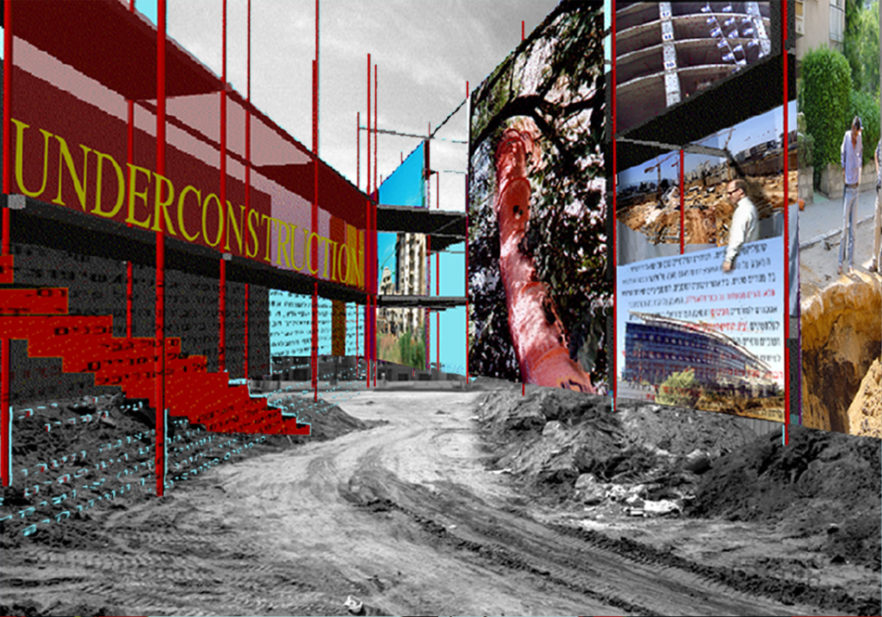Transformations in Israeli architectural consciousness
Following the “Israeli pavilion”exhibition
The “Israeli pavilion” exhibition(1) was presented in the Architects’ House Gallery in Jaffa, in July-August 2002. The exhibition presented Israeli proposals for two international architectural exhibitions: The Architecture Biennale in Venice, which opened in September 2002, and proposals for the International Union of Architects (UIA), which was conducted in Berlin in July 2002. The exhibition took place at a moment of change. A moment in which new directions were formed in the Israeli architecture by a new generation of architects, curators and researchers, who identify in the Israeli architecture clear trails of Israeli politics. The works in the exhibition proposed a critical reading of the local architecture.
The candidates for curators of the Israeli pavilion at the Venice Biennale were summoned by a sub-committee appointed by the Department of Art in the Culture Administration of the Israeli Ministry of Science, Culture and Sport. The candidates for curators of the Israeli pavilion at the International Union of Architects in Berlin were summoned by a steering committee appointed by the Israeli Association of United Architects. The architect Zvi Efrat and his team were chosen, and he curated the Israeli pavilion in the Venice Biennale. The architects Rafy Segal and Eyal Weizman were chosen as curators of the Israeli exhibition at the international architects’ congress in Berlin. However, the committee eventually rejected Segal and Weizmans’ final work – a catalogue and a collection of articles that appeared under the headline “Civilian Occupation, the Politics of Architecture” (Segal and Weizman, 2002) – due to its political position. The works of an exhibition that had already been presented in the Architects’ House Gallery were finally sent to Berlin, presenting projects that were built in Israel in recent years.(2) The affair raised questions regarding the extent to which Israeli architecture and the professional union representing Israeli architects are political, and regarding the freedom to express a political, harsh and extreme position in an international exhibition. The Berlin case reflected both the change of consciousness in Israeli architecture and the resistance that this change has awakened in the architectural community. At the end of the day, canceling the exhibition did not silence its political messages, awakening instead a storm within the Israeli architects’ community, which developed into a dispute in the printed media(3) (Zandberg, 2002,2003). The story was also widely discussed in the international media (Ruding, 2002), following which the curators, architects Segal and Weizman, were invited to lecture and present their work in various places in the world.
In the attached article, I shall present the “Israeli Pavilion” exhibition and the occurrences surrounding the Berlin Congress, as a test case for the coming of age of the architectural discourse in Israel. In the first sections of the article, I shall discuss the visual and textual representation of Israeli architecture, presenting the difficulties that exhibiters encounter when they are required to translate the problems of local architecture into universal language and to embrace an international agenda. Furtheron, I shall present the Israeli “sense of place”, as it is presented in the works of the “Israeli Pavilion” exhibition, as a site of construction and destruction.(4) I shall point out the relation between architecture in Israel and the politics of this state, observing the new local discourse that is replacing the regional discourse in Israeli architecture and attempt to outline the theoretical context of its transition into a political discourse. On the basis of the findings of this survey, I shall point out the gallery or the museum as a site for establishing the Israeli critical image. Finally, I shall discuss the critical possibilities that this exhibition is opening up for architectural theory and practice.

1 As curator of the Architects’ House Gallery, as submitter of one of the proposals for the Venice Biennale, and as participant in meetings of the steering committee appointed by the United Architects’ Association for the Berlin exhibition, I appealed to the heads of the committees that chose the candidates, and through them to the various candidates, in a request to present their proposals in a combined exhibition. Seven out of the nine candidates for the Venice Biennale, and five out of the six candidates for the Berlin exhibition, consented to exhibit their work, which was then presented in the “Israeli Pavilion” exhibition. The works that were presented in the exhibition were usually faithful to the primary idea that had been presented to the choosing committees.
2 The works that were sent were taken from the exhibition “Space 2001 – The Israeli Architecture Biennale”, which was presented in January 2002 in the Architects’ House Gallery, and curated by the Exhibition Committee of the United Architects’ Association in Israel.
3 Esther Zandberg, architecture critic of the “Haaretz” newspaper, brought this affair to the knowledge of the general public. Zandberg criticized the decision that was made by the United Architects’ Association in Israel, to reject Segal and Weizman’s work.